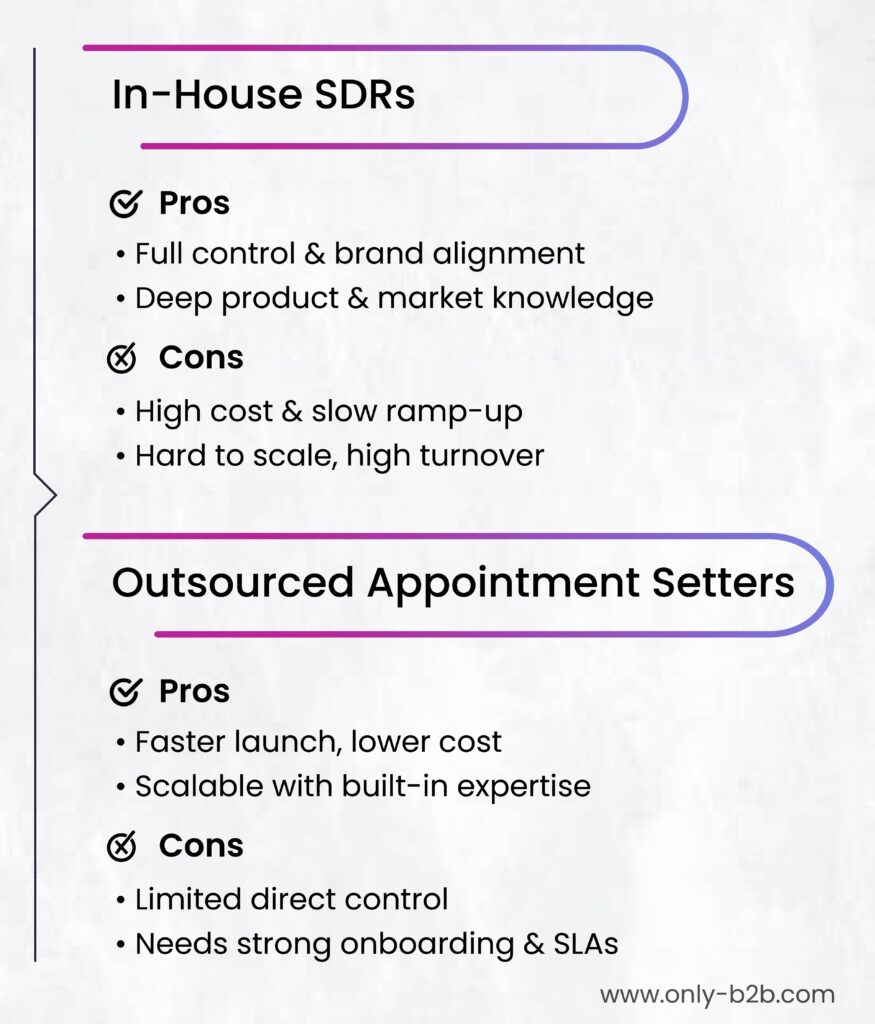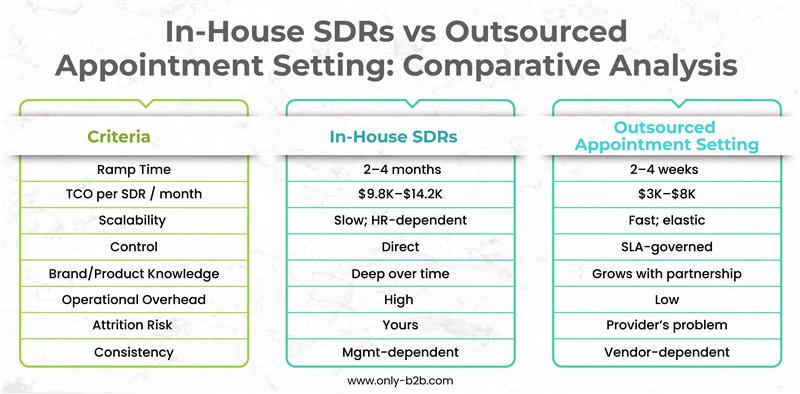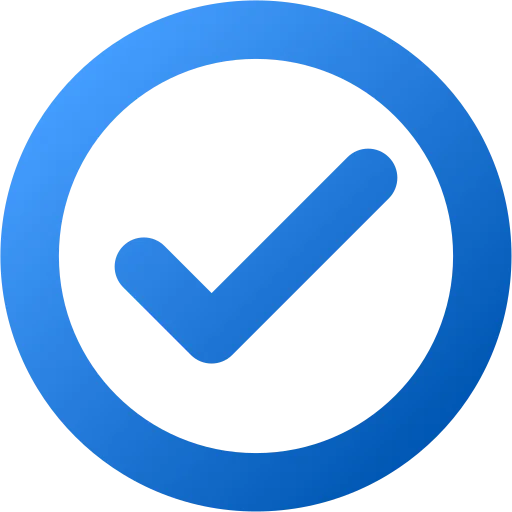Is the health of your pipeline deteriorating? If so, it means it’s suffocated with tighter budgets, rising growth expectations
Amidst this, leadership teams face a pivotal question:
Should we build our appointment-setting team in-house or outsource it?
And this decision has direct financial implications. How and why? In this blog, we’ll use data, cost formulas, and ROI calculations backed by real-world insights and actionable frameworks to help you evaluate models.
By the end of it, you’ll surely make the best decision for your business goals. Spoiler alert: there’s no one-size-fits-all answer. It’s one that aligns best with your strategy.
Let’s dive in.
Understanding In-House SDR and Outsourced Appointment Setting
Table of Contents
- 1 Understanding In-House SDR and Outsourced Appointment Setting
- 2 Pros, Cons and Trade-offs
- 3 In-House SDRs: Cost Formula and Breakdown
- 4 Outsourced Appointment Setting: Cost Formula and Breakdown
- 5 Comparative Analysis Table
- 6 When Outsourcing Makes the Most Sense
- 7 When In-House Still Wins
- 8 The Hybrid and Blended Approach
- 9 How Futuristic Teams Use AI and Automation in Outsourced SDR Models
- 10 Actionable Takeaways for B2B Leaders
- 11 Conclusion
1. In-House SDR Team
You hire, train, and manage your own Sales Development Representatives. They operate within your company systems (like Salesforce or HubSpot), embody your culture, and handle outreach under your supervision.
You control:
- Recruitment and training
- Messaging and KPIs
- Daily management and performance
You pay for:
- Salaries, commissions, and benefits
- Software tools and management overhead
- Hiring, ramp-up, and turnover costs
2. Outsourced Appointment Setting / SDR-as-a-Service
A specialized partner manages appointment setting end to end. You define your Ideal Customer Profile (ICP), messaging guidelines, and outcomes while they execute and optimize.
You get:
- Pre-trained SDRs
- Ready tech stack and multi-channel outreach
- Reporting, analytics, and optimization
You pay for:
- Monthly retainer or per-SDR cost
- No hiring, HR, or management overhead
Pros, Cons and Trade-offs
You’ve probably been burned before. Maybe an SDR quit after six months or an agency delivered low-quality meetings. Skepticism is real. Let’s break down what really matters.
In-House: Pros and Cons

Full control and cultural alignment.
Great for brand nuance and highly technical narratives. But your leaders must invest full-time effort to maintain the bar.
Seamless collaboration with AEs and Marketing.
Proximity allows speedy feedback; however, in-house meetings often eat into valuable sales call time.
Institutional knowledge.
SDRs can grow into AE or CSM roles, but high turnover often disrupts ramp-up and overall productivity.
Outsourced: Pros and Cons
Speedy results.
Go live in weeks, not quarters. Partnering with vendors who skip proper onboarding, enablement, and shared scorecards is risky.
Cost flexibility.
High investment (typically $3K–$8K per month per SDR-equivalent). You can quietly scale back without severance or morale fallout.
Built-in expertise.
You gain cross-industry patterns, A/B testing rhythms, and tech stack discipline. However, keeping up with the product story through updates, call libraries, and enablement assets can be challenging.
Operational relief.
Your leaders can focus on strategy and closing. But “outsourced” doesn’t mean “hands-off” — run weekly alignment sessions and review shared dashboards for best results.
In-House SDRs: Cost Formula and Breakdown
Teams often add up salary and tools but forget the drag from ramp and churn. That’s where the “we own it” confidence shatters.
Formula:
Total Annual Cost per SDR = (Base Salary + Benefits and Commissions) + Tooling Costs + Overhead Costs + Ramp and Turnover Losses
| Component | Estimated Cost (USD) | Notes |
| Base Salary | $65,000/year | Typical mid-market SDR salary (U.S.) |
| Benefits and Commission | $20,000/year | 30% of base salary |
| Tools (CRM, sequencing, data, etc.) | $5,000/year | Sales tools and licenses |
| Management and Overhead | $15,000/year | Manager cost allocation and workspace |
| Ramp-Up Loss (3 months avg.) | $12,000 | Lost productivity |
| Turnover Replacement (avg. 40%) | $8,000 | Recruiting and downtime cost |
Calculation:
65,000 + 20,000 + 5,000 + 15,000 + 12,000 + 8,000 = 125,000
Total Annual Cost per In-House SDR: $125,000
Monthly Cost = 125,000 ÷ 12 ≈ $10,416
So, the average monthly fully loaded cost = $10,000 to $14,000, depending on region and ramp rate (as confirmed by OutboundSalesPro, 2025).
Outsourced Appointment Setting: Cost Formula and Breakdown
You might fear that outsourcing hides costs or includes markups that make it less efficient long-term. However, with an efficient outsourcing partner, it simplifies to a steady run rate plus performance incentives.
Formula:
Total Annual Cost per SDR Equivalent = (Monthly Retainer × 12) + Performance Add-ons (if any)
| Component | Estimated Cost (USD) | Notes |
| Monthly Retainer | $5,000 | Industry average mid-tier plan |
| Performance Bonus (optional) | $3,000/year | For exceeding KPIs |
| Onboarding/Setup (one-time) | $2,000 | Data alignment and campaign setup |
Calculation:
(5,000 × 12) + 3,000 + 2,000 = 65,000
Total Annual Cost per Outsourced SDR: $65,000
Monthly Cost = 65,000 ÷ 12 ≈ $5,416
That’s approximately 48% less than a typical in-house SDR while offering built-in expertise, infrastructure, and flexibility.
Comparative Analysis Table

When Outsourcing Makes the Most Sense
Is outsourcing just for startups or lean teams anymore? Will we lose our internal sales rhythm?
By highlighting speed, scalability, and flexibility, you outsource for growth, not desperation.
- Build Pipeline Fast
If you’re entering a new region or targeting a fresh ICP, outsourced teams can launch campaigns within weeks and generate qualified meetings rapidly. - Maximize Limited Bandwidth
It saves you from lengthy hiring cycles, HR management, and training, letting you focus on core revenue operations. - Handle Growth or Seasonal Demand
Outsourcing provides elasticity, allowing you to scale up during peak seasons or pilot new verticals without requiring permanent hires. - Test or Validate Markets
Ideal for experimenting with pilot messaging and new markets before building a dedicated in-house unit.
When In-House Still Wins
For certain businesses, keeping SDRs internal makes more sense. The in-house system works best when:
- The Sales Process Is Highly Technical
Industries with niche markets benefit from in-house SDRs because they are immersed in product knowledge and regulatory nuances. - You’re Focused on Long-Term Talent Development
Building future AEs or Customer Success Managers from within requires maintaining control over SDR growth and training. - Brand Experience Is Paramount
If your outreach requires hyper-personalization and tone precision (for example, enterprise ABM), in-house control ensures every message mirrors your brand perfectly.
The Hybrid and Blended Approach
Now you’re seeking a low-risk bridge, right? Something between commitment and flexibility.
The most forward-thinking B2B organizations are adopting hybrid models, blending the strengths of both approaches.
Hybrid Teams:
Internal SDRs handle complex, strategic accounts while outsourced teams focus on high-volume or early-stage outreach.
Pilot Programs:
Start with outsourcing to validate ICPs and campaigns, then internalize successful playbooks.
Co-Managed Models:
Collaborate with providers in real-time, sharing data and feedback for a synchronized approach.
Choose the best-of-both-worlds strategy. It gives you flexibility, control, and scalability without committing entirely to one side.
How Futuristic Teams Use AI and Automation in Outsourced SDR Models
AI is powering up outsourced appointment setting to make it even smarter.
- AI-Powered Targeting and Cadence Optimization
AI tools help providers identify buying intent faster, personalize outreach at scale, and time follow-ups for maximum impact. - Intent Data and ABM Integration
Leading providers integrate seamlessly with ABM platforms and intent data signals such as G2 or Bombora.
When every outreach is backed by buyer intent and contextual insights, you can expect higher connect rates. - Efficiency and Productivity Gains
With AI, SDR teams can boost productivity by 20 to 30 percent (Gartner), thanks to automation in data research, prospect scoring, and email personalization.
Partnering with outsourced providers gives you access to advanced tech ecosystems without additional investment.
Actionable Takeaways for B2B Leaders
- Calculate True Cost, Not Just Salary:
Include ramp-up time, management costs, attrition, and tech tools in your TCO analysis before deciding. - Pilot, Measure, and Iterate:
Run a 90-day pilot with an outsourced provider using clear SLAs (meetings held, not just booked) to validate ROI. - Focus on Outcome Metrics:
Track pipeline generated, meeting show rates, and conversion ratios, not vanity metrics like calls made. - Treat Partners as Strategic Extensions:
Regular enablement sessions, feedback loops, and shared dashboards create alignment and accountability. - Plan for Evolution:
Your ideal model may evolve as your company scales, products diversify, or new markets open up. Stay flexible.
Conclusion
“We can revisit this next quarter.”
This is a familiar phrase, seemingly safe, rational, and harmless. But in B2B sales, waiting means losing pipeline to competitors.
Every quarter you postpone optimization, you’re leaving measurable pipeline value on the table.
Outsourced appointment setting isn’t just a cost-saving lever; it’s a time-saving one. The winner isn’t the one who books more meetings but the one who consistently converts those meetings into a pipeline.
Ready to see how an outsourced model could reshape your pipeline economics?

Vikas Bhatt is the Co-Founder of ONLY B2B, a premium B2B lead generation company that specializes in helping businesses achieve their growth objectives through targeted marketing & sales campaigns. With 10+ years of experience in the industry, Vikas has a deep understanding of the challenges faced by businesses today and has developed a unique approach to lead generation that has helped clients across a range of industries around the globe. As a thought leader in the B2B marketing community, ONLY B2B specializes in demand generation, content syndication, database services and more.





